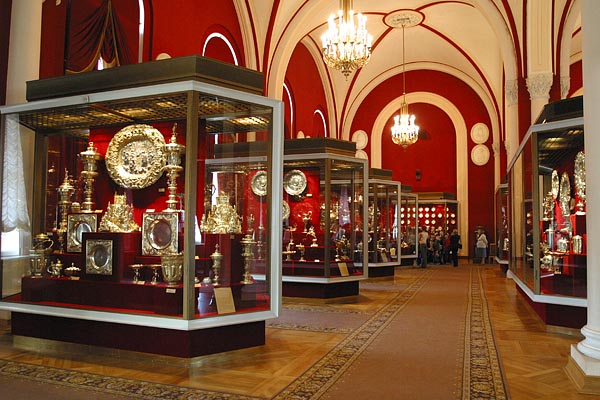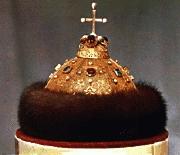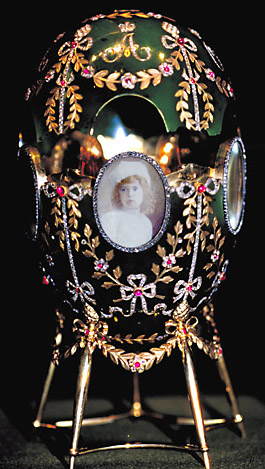
by Richard W. Wise
©2010
Greetings all; my wife Rebekah and I left late last week for a vacation tour of Moscow, St. Petersburg and Tallinn, Estonia. We are also spending a few days in London.
Our first stop was Moscow. As part of our tour, we visited the The Armoury. Founded in 1806 by imperial decree, the former munitions storehouse encloses the most important exhibits of Russia’s National Museum of History and Culture including the State collection of gems and jewels. The building stands at the southwest section of the Kremlin in central Moscow. Located within the Armoury is The Diamond Fund, aptly named, it is a small museum within a museum and is the repository for the finest of the jewels that are part of the Russian national collection.
Visiting The Diamond Fund is not easy. Though many visitors tour The Armoury, few make the advance reservations or are willing to pay the $130.00 per person required for a one hour unguided tour.
Beginning the Tour: Inside The Armoury:
We began our tour in The Armoury proper and the first thing that struck me as we gazed into the cases in Room 1, which houses items of gold from the 12th through 17th Centuries is the prevalence of emerald as a decoration in some of the oldest pieces. Many of the items on exhibit are religious objects including, several manuscript Bibles with highly decorated, carved, chased, repousée and niello silver covers. Th ese hand written scriptures were encrusted with gems the most prevalent of which are agates, emeralds and natural pearls. One object, a 14th Century reliquary, includes numerous large cabochon emeralds, most hardly more than water worn pebbles, which displayed rather good color. The 14th Century Crown of Monomachus, sort of a Russian fur cap with a gold crown is decorated by several large rectangular faceted emeralds as well as sapphire, spinel?, rock crystal and pearls.

Monomachus Cap. Late 14th Century. A golf carved filagreed cap set with cabochon emerald, sapphire, spinel and pearls
The Colombian emerald mines were conquered in the 1560s, so emeralds dating from this period are certainly not from that source. It is tempting to suggest that these are Uralian emeralds, however, several of these objects are thought to be of Byzantine manufacture and given that some emeralds from the Roman period have been traced to Pakistan, it is not possible to tell the exact source without testing.
Sapphire and Tourmaline:
All of the metalwork is housed in a large dimly lit vaulted chamber within the Armoury. The light is challenging. I saw a number of blue sapphires with color and inclusions that suggest Ceylon origin and though I can’t be sure, I can’t think of another possibility.
Made in 1731 by G. W. Dunkel, this crown in surmounted by a magnificent uncut red tourmaline of exceptionally pure red hue.
Another surprise, tourmaline! There are several lovely tourmalines, particularly reds, used as primary decorations on a number of the pieces in both The Armoury and The Diamond Fund. One example, a crown made in 1730 by goldsmith G. W. Dunkel in St. Petersburg for Empress Anne is surmounted by a gigantic uncut alluvial peable of red tourmaline. More about tourmaline in the next post.
The Goldsmith’s Art:
The goldsmiths work is exceptional. Repousée, a process by which a three three dimensional bas relief is formed by placing sheet gold or silver upside down in a bowl of warm pitch is breathtaking. Once cool, the pitch both holds and cushions the metal and a series of shaped hardened metal tools are used to push the metal outward. Once the figure is formed, the metal is turned right side up and small details are pushed and chiseled or “chased” in using smaller, finer edged tools. By these processes, small figures of Christ and the saints were beautifully rendered with minute detail.
Russian goldsmiths were masters of enameling and niello. Silver and yellow gold are a fairly restricted palette, one can be used to gild the other, but that is about it. Niello is a alloy of silver, lead and copper of varying mixtures and a low melting point that becomes gray to black and flows easily into chased or carved filigreed recesses in either gold or silver and can create contrasts that bring out the finer details in the host metal.
Fabergé Eggs:
The Armoury also holds Russia’s fifteen remaining Fabergé Imperial Easter Eggs. A majority of these eggs, gifts to the Czarina by the ill fated Czar Nicholas II, were spirited out of Russia after the revolution by the American industrialist Armand Hammer and now reside in the
United States. Each of the eggs is a masterpiece of the goldsmith’s art. (Pictured Anastasia’s Egg). Faberge was known particularly for his use of enamels. This technique involves the fusing of powdered colored glass to the metal’s surface in a kiln at high temperatures. Each color, each changing nuance requires an additional firing. To give the impression of depth, Fabrege sometimes used as many of six firing for a single color. The workshop is reputed to have used 500 different colors.
Pearls:
Pearls were used in large numbers to decorate many of the objects, particularly the icon frames. We saw sizes up to 7-9mm in round as well as many semi-round and baroque shapes. For the most part the pearls exhibited a dull luster, which is probably the result of age and poor storage.

